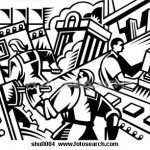The study of economics was originally called political economy because classical economists readily acknowledged that monetary policies were determined by the state, or at least its most affluent social groups. But as economic theories and fiscal policy development became more complex, economics became a distinct science, and seemingly shed its political origins.

Now, it seems, this may not be the case, especially when it comes to examining the causes of stagnant real wages and how they affect everything from retirement and wealth planning to job creation and rising living standards.
So how important is this seemingly esoteric economic concept of real wages?
Real wages are important since they measure an individual’s purchasing power. And since consumer spending accounts for two-thirds of the U.S. economy, derailing wage growth portends stagnant GDP growth in every consumer segment ranging from clothing to home purchases.
When purchasing power is diminished for the middle class, they do what any red-blooded American would do: they go into debt. In previous recessions, the dual actions of the middle class assuming more debt, combined with expansionary fiscal policies (more infra-structure building, government spending and applying Keynsian policies) accelerated recoveries and created more jobs.
But as economist Ravi Batra wrote in 2005, a few years before the start of the current recession, “the chief reason for post-crash stagnation is all the debt buildup among consumers, and the over-investment among producers and homeowners that occurred during the prior euphoric years.” When rates fell to near-zero, as they did in Japan, it still did not encourage consumers to spend more. So when indebted consumers also face wage stagnation, especially after a bubble bursts, it is accompanied by rising unemployment and sinking wages, Or as Batra said in his book, “at a maximum, it is a depression.”
It also affects retirement planning and 401(k) education efforts since numerous studies show that Americans are not saving enough. This low savings rate has even prompted some to say Americans have no self-control and must be blamed because they are not saving enough or, despite the penalties, are borrowing from their 401(k)s. Yet the real cause for the slow recovery and inadequate financial planning may be much more simple: Maybe the average worker needs a raise.
Maybe it is time to discuss stagnant real wages and acknowledge that any household has an income and an expense side to its budget. When expenses rise and incomes stagnate, people still have to eat.
A Historical Break
While real wages have historically kept pace with productivity, with the exception of the 1920s and during the period from 1979 to 2009 when productivity increased by 80%, hourly wages only increased 10%. Yet even during this period, all the wage growth occurred from 1996 to 2002, reflecting the strong economic growth of the 1990s before the high tech and Y2K crash of 1999 to 2000. (For more see “How 401(k) Fees Destroy Wealth and What Investors Can Do To Protect Themselves.”)
Since the mid-1970s, real wages have been stagnant. The Economic Policy Institute (EPI), one of the few think tanks to even address this critical topic, found that the average hourly wages for workers in 2007 dollars was $18.90 in 1973 and $21.34 in 2006. This converts to a 13% wage increase in 33 years, or a growth rate of 0.04% per year.
Most recently, the EPI found that the era of flat wages, accompanied by the loss of pensions and 401(k)s (aka “overall compensation”), combined with and rising health care costs, has hit the middle class hardest.
In their latest white paper, the EPI said “This lost decade for wages comes on the heels of decades of inadequate wage growth. For virtually the entire period since 1979 (with the one exception being the strong wage growth of the late 1990s), wage growth for most workers has been weak. The median worker saw an increase of just 5% between 1979 and 2012, despite productivity growth of 74.5%—while the 20th percentile worker saw wage erosion of 0.4% and the 80th percentile worker saw wage growth of just 17.5%.” This again notes the break between productivity gains and wage increases.
Why the Break?
The EPI study also found that between 2007 and 2012, wages fell for the entire bottom 70% of the wage distribution, despite productivity growth of 7.7%. “In other words, the vast majority of wage earners have already experienced a lost decade, one where real wages were either flat or in decline,” the study found.
Wage gaps occur due to changes in labor supply and demand, regressive tax policies, industry consolidations due to mergers, technology, and the erosion of the power of labor unions to push wages higher. In addition, attacks on the minimum wage, and even calls for its elimination, will only increase wage stagnation.
Real wage growth is also a key concern of the Fed. While it is a significant economic issue, Fed policy focuses on balancing inflation and job creation among its mandates.

But inflation is the more important variable to control, at least based on 1997 comments by then-Fed Chairman Alan Greenspan who said when workers had poor job security they were more reluctant to ask for higher wages and this would serve as eliminating a major cause of inflation.
Who Gets Hurt the Most
Yet stagnant real wages are only part of the story for most Americans. The other weight comes from the wealth destruction caused by the 2008 recession.

From 2005 to 2010, the media net worth of white Americans fall by 23%. Yet during that same period, the drop was about 60% for black and Hispanic households. According to U.S. Census data, the 2007 recession aggravated the wealth gap since home foreclosures were greater among blacks and Hispanics who relied more on sub-prime mortgages.
A July 2011 Pew Research Center study showed the huge wealth gap between blacks and Latinos versus whites. The study found “lopsided wealth ratios” of white households were 20 times that of black households and 18 times that of Hispanic households.
This gap will become worse and unbridgeable for at least a generation if it can be closed at all. Historians have noted that huge wealth gaps endanger and erode entire civilizations. The current wage gap, which is only aggravated by stagnant incomes, is not the foundation for a sustainable national future.










